抗体的纯化原理与方法
抗体纯化工艺
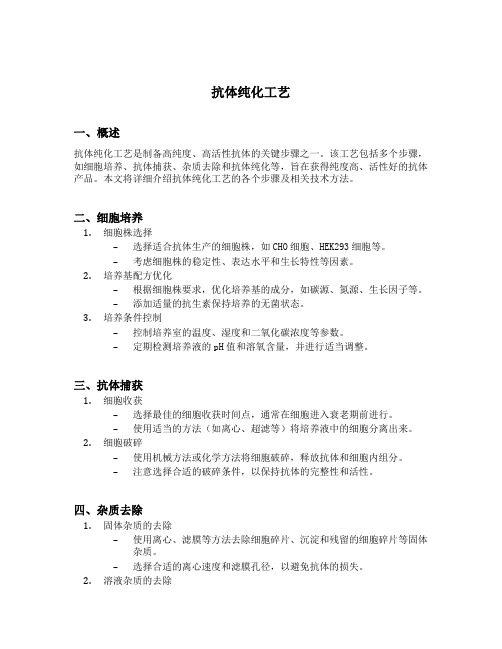
抗体纯化工艺一、概述抗体纯化工艺是制备高纯度、高活性抗体的关键步骤之一。
该工艺包括多个步骤,如细胞培养、抗体捕获、杂质去除和抗体纯化等,旨在获得纯度高、活性好的抗体产品。
本文将详细介绍抗体纯化工艺的各个步骤及相关技术方法。
二、细胞培养1.细胞株选择–选择适合抗体生产的细胞株,如CHO细胞、HEK293细胞等。
–考虑细胞株的稳定性、表达水平和生长特性等因素。
2.培养基配方优化–根据细胞株要求,优化培养基的成分,如碳源、氮源、生长因子等。
–添加适量的抗生素保持培养的无菌状态。
3.培养条件控制–控制培养室的温度、湿度和二氧化碳浓度等参数。
–定期检测培养液的pH值和溶氧含量,并进行适当调整。
三、抗体捕获1.细胞收获–选择最佳的细胞收获时间点,通常在细胞进入衰老期前进行。
–使用适当的方法(如离心、超滤等)将培养液中的细胞分离出来。
2.细胞破碎–使用机械方法或化学方法将细胞破碎,释放抗体和细胞内组分。
–注意选择合适的破碎条件,以保持抗体的完整性和活性。
四、杂质去除1.固体杂质的去除–使用离心、滤膜等方法去除细胞碎片、沉淀和残留的细胞碎片等固体杂质。
–选择合适的离心速度和滤膜孔径,以避免抗体的损失。
2.溶液杂质的去除–使用离子交换、凝胶过滤、亲和层析等方法去除溶液中的蛋白质、DNA、RNA等杂质。
–根据目标抗体的特性选择合适的去除方法。
五、抗体纯化1.亲和层析–使用亲和介质(如蛋白A、蛋白G、蛋白L等)将目标抗体从其他成分中分离出来。
–根据目标抗体的种类选择合适的亲和介质。
2.离子交换层析–利用抗体与离子交换介质之间的电荷相互作用进行分离。
–通过调整pH值、盐浓度等参数来实现对抗体的选择性吸附和洗脱。
3.凝胶过滤层析–利用凝胶过滤介质的孔径大小选择性地分离抗体。
–根据抗体的分子量和亲和性选择合适的凝胶过滤介质。
4.逆流色谱–利用逆流色谱技术实现对抗体的纯化和富集。
–通过改变流动相和温度等条件来调节抗体与逆流色谱介质之间的相互作用。
抗体纯化方法

抗体纯化方法1. 引言抗体是一类免疫蛋白,具有识别和结合特定抗原的能力。
在生物医学研究和临床应用中,纯化高质量的抗体是非常重要的。
抗体纯化方法可以去除杂质,提高抗体的纯度和活性,从而提高其应用效果。
本文将介绍几种常见的抗体纯化方法。
2. 凝胶过滤层析法凝胶过滤层析法是一种基于分子大小的纯化方法。
该方法利用不同孔径的凝胶过滤介质,将目标分子(如抗体)与较大分子(如蛋白质杂质)分离开来。
具体操作步骤如下:1.将含有目标抗体的混合物加入到预先平衡好的凝胶柱中。
2.使用缓冲液进行洗脱,使较大分子无法通过凝胶柱而流出。
3.目标抗体由于分子大小适中,能够通过凝胶柱被保留下来。
4.最后使用洗脱缓冲液将目标抗体从凝胶柱中洗脱出来,得到纯化的抗体。
凝胶过滤层析法的优点是简单易行,不需要特殊设备,且适用于各种规模的实验室。
但其缺点是分离效率较低,只能实现较为粗略的纯化。
3. 亲和层析法亲和层析法是一种基于生物分子之间特异性相互作用的纯化方法。
该方法利用抗体与抗原之间的特异性结合来实现目标抗体的纯化。
具体操作步骤如下:1.将含有目标抗体的混合物加入到预先包含特异性结合配体(如蛋白A、蛋白G等)的亲和层析柱中。
2.目标抗体与配体之间发生特异性结合。
3.使用洗脱缓冲液将非特异结合的组分洗脱掉。
4.最后使用洗脱缓冲液将目标抗体从亲和层析柱中洗脱出来,得到纯化的抗体。
亲和层析法具有高选择性和高效率的优点,能够得到高纯度的抗体。
但其缺点是需要特定的亲和剂和配体,成本较高。
4. 离子交换层析法离子交换层析法是一种基于生物分子表面电荷的纯化方法。
该方法利用目标抗体与离子交换柱中固定的离子之间的相互作用来实现纯化。
具体操作步骤如下:1.将含有目标抗体的混合物加入到预先平衡好的离子交换柱中。
2.使用缓冲液进行洗脱,使与固定离子相同电荷的分子无法通过离子交换柱而流出。
3.目标抗体由于表面电荷不同,能够通过离子交换柱被保留下来。
4.最后使用洗脱缓冲液改变pH或盐浓度等条件,将目标抗体从离子交换柱中洗脱出来,得到纯化的抗体。
抗体纯化的基本流程
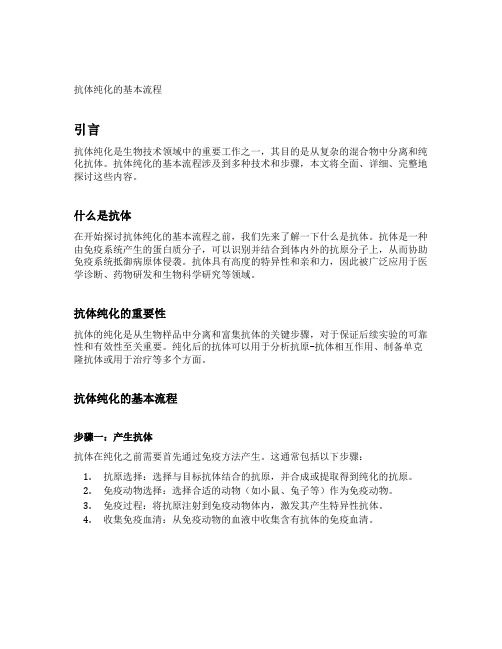
抗体纯化的基本流程引言抗体纯化是生物技术领域中的重要工作之一,其目的是从复杂的混合物中分离和纯化抗体。
抗体纯化的基本流程涉及到多种技术和步骤,本文将全面、详细、完整地探讨这些内容。
什么是抗体在开始探讨抗体纯化的基本流程之前,我们先来了解一下什么是抗体。
抗体是一种由免疫系统产生的蛋白质分子,可以识别并结合到体内外的抗原分子上,从而协助免疫系统抵御病原体侵袭。
抗体具有高度的特异性和亲和力,因此被广泛应用于医学诊断、药物研发和生物科学研究等领域。
抗体纯化的重要性抗体的纯化是从生物样品中分离和富集抗体的关键步骤,对于保证后续实验的可靠性和有效性至关重要。
纯化后的抗体可以用于分析抗原-抗体相互作用、制备单克隆抗体或用于治疗等多个方面。
抗体纯化的基本流程步骤一:产生抗体抗体在纯化之前需要首先通过免疫方法产生。
这通常包括以下步骤:1.抗原选择:选择与目标抗体结合的抗原,并合成或提取得到纯化的抗原。
2.免疫动物选择:选择合适的动物(如小鼠、兔子等)作为免疫动物。
3.免疫过程:将抗原注射到免疫动物体内,激发其产生特异性抗体。
4.收集免疫血清:从免疫动物的血液中收集含有抗体的免疫血清。
步骤二:预处理样品在开始抗体纯化之前,通常需要对样品进行一些预处理步骤,以去除杂质和提高纯化效果:1.样品收集:收集包含抗体的样品,如免疫动物的血清或细胞培养上清液。
2.去除大分子杂质:通过使用滤器或超速离心的方法,去除样品中的大分子杂质,如胶原蛋白、细胞碎片等。
步骤三:亲和层析亲和层析是抗体纯化中最常用的方法之一,它基于抗体与特定配体(如抗原或蛋白A/G)的高亲和性实现抗体的分离和富集。
1.根据抗体的特性选择合适的配体:根据抗体的免疫来源和特性,选择能够与之高亲和结合的配体。
2.固定配体:将配体固定在固相支持材料上,如琼脂糖、琼脂糖糖胶等。
3.样品加载:将预处理后的样品加入到亲和层析柱中。
4.洗脱:通过改变洗脱缓冲液的条件,如改变pH值、离子强度等,洗脱不结合的杂质。
抗体纯化工艺

抗体纯化工艺一、引言抗体是一种重要的生物大分子,具有广泛的应用前景。
在许多领域中,如医学、生物技术和生命科学等方面都有着重要的应用。
抗体的纯化是研究和应用这些分子的基础,因此抗体纯化工艺显得尤为重要。
二、抗体纯化工艺流程1. 细胞培养及收获细胞培养是抗体制备的第一步,通常使用哺乳动物细胞系来表达目标蛋白。
细胞培养条件包括温度、CO2浓度、营养成分和培养基等。
当细胞达到最大密度时,可以进行收获。
收获后将细胞离心并取下上清液。
2. 亲和层析亲和层析是最常用的抗体纯化方法之一。
它利用特定配体与目标分子之间的亲和作用,将目标分子从混合物中选择性地吸附到固相材料上。
例如,使用含有蛋白A或蛋白G的树脂来选择性地捕捉IgG类别的抗体。
3. 尺寸排除层析尺寸排除层析是一种基于分子大小的分离方法。
它利用不同分子大小的抗体在树脂中的渗透性差异,从而实现对目标分子的纯化。
尺寸排除层析通常用于去除杂质,如细胞碎片、DNA和RNA等。
4. 离子交换层析离子交换层析是一种利用不同离子性质进行分离的方法。
在这种方法中,树脂表面上带有正负电荷的功能团能够与目标抗体中带有相反电荷的部位结合。
通过调节pH或盐浓度,可以实现目标抗体与树脂之间的选择性结合和解离。
5. 亲水性交换层析亲水性交换层析是一种基于溶液中物质亲水/疏水特性进行分离的方法。
它利用具有不同亲水性质的树脂来选择性地捕捉和纯化目标抗体。
6. 逆流色谱逆流色谱是一种高效液相色谱技术,在抗体制备中也有广泛应用。
它可以快速地分离和纯化目标抗体,并且可以在大量样品中进行高通量分析。
7. 超滤超滤是一种利用膜过滤器进行分离和纯化的方法。
它可以去除大分子杂质,如细胞碎片、DNA和RNA等,从而提高目标抗体的纯度。
三、结论抗体纯化工艺是抗体制备中不可或缺的一部分。
通过合理地设计和选择不同的纯化方法,可以实现高效、快速和经济地纯化目标抗体。
在实际应用中,需要根据具体情况选择合适的工艺流程,并进行优化和改进,以提高抗体的产量和质量。
抗体纯化的方法有哪些

抗体纯化的方法有哪些抗体纯化是一种将杂质和其他成分从混合物中分离出抗体的过程。
采用不同的方法可以实现抗体的纯化,具体方法取决于纯化过程中抗体与其他成分之间的特定相互作用。
以下是常见的抗体纯化方法:1. 亲和层析(Affinity chromatography):基于抗体与目标抗原之间的高特异性结合作用。
可以使用结合在固定支持介质上的目标抗原来精确地捕获抗体。
2.蛋白A、蛋白G和蛋白L亲和层析:这些层析方法基于蛋白质和抗体之间的亲和性。
蛋白A、蛋白G和蛋白L是一类结合在细菌细胞壁上的蛋白质,它们与抗体Fc区域的不同部位结合,因此可以用于从混合物中富集抗体。
3. 离子交换层析(Ion exchange chromatography):基于抗体与离子交换基质之间的相互作用来实现分离纯化。
通过调节溶液的pH值,可以控制离子交换基质上的电荷,从而实现对抗体的选择性捕获。
4. 尺寸排阻层析(Size exclusion chromatography):通过根据抗体与其他分子的大小差异来实现分离纯化。
大分子如抗体会快速通过填充在柱内的孔隙,而较小分子则会被孔隙所限制,因此可以通过尺寸选择性地捕获和纯化抗体。
5. 亲和吸附(Affinity adsorption):用于捕获抗体的固定介质上表面共价或非共价地固定目标抗原,然后将混合物通过固定介质,使抗体与目标抗原相互作用,并通过洗涤和再生步骤来清除杂质。
6.电泳分离:电泳是基于分子在电场中迁移速率的差异来实现纯化的方法。
通过电泳可以将抗体与其他成分分离开来。
7.沉淀和沉降:使用盐类、有机溶剂或其他物质来促使抗体的沉淀或沉降,然后可以通过离心等方法将其与上清液分离开。
8. 磷酸铵沉淀(Ammonium sulfate precipitation):将逐渐增加浓度的磷酸铵加入混合物中,使抗体产生沉淀,在沉淀过程中可以通过离心等方法将其分离出来。
9. 过滤法(Filtration):通过使用滤膜和适当的压力或真空来分离大分子(如抗体)和小分子。
抗体的提取与纯化

抗体的提取与纯化精制免疫球蛋白的方法很多。
一般采用综合技术,避免蛋白变性。
如分离IgG时,多结合使用盐析法与离子交换法,以求纯化。
提取IgM的方法也很多,如应用凝胶过滤与制备电泳法,或离子交换与凝胶过滤等。
一、盐析法1 取x ml血清加x ml生理盐水,于搅拌下逐滴加入2xml饱和硫酸铵,硫酸铵的终饱和度为50%。
2置4℃,3h以上,使其充分沉淀离心(3000rpm),20min,充上清,以xml生理盐水溶解沉淀,再逐滴加饱和硫酸铵x/2ml。
3 置4℃3h以上,[此时,(NH4)2SO4的饱和度为33%]重复上述第二步过程1~2次。
4 末次离心后所得沉淀物为γ-球蛋白,以0.02mol/L pH7.4 PBS溶解至xml装入透析袋。
对PBS 充分透析、换液3次,至萘氏试剂测透析外液无黄色,即无NH4+为止。
5 取透析袋内样品少许作适当倍数稀释后,以751型紫外分光光度计测定蛋白含量。
影响盐析的因素很多,如蛋白质的浓度,盐的浓度,饱和度和pH,温度等都可影响盐析的结果,操作时要充分注意(参阅本章第二节)。
二、冷酒精沉淀法分离过程如下。
血清加3倍体积的蒸馏水,调节pH至7.7(±)冷却到0℃。
在激烈搅拌的条件下,加预冷的酒精(-20℃)到最终浓度为20%,保持在-5℃。
产生的沉淀(A),含有大多数种类的免疫球蛋白。
沉淀A悬浮于25倍体积的0.15~20mol/L NaCl溶液(冷)中,加有0.05mol/L醋酸调节pH到5.1,产生的沉淀(B),包括大部分的IgA和IgM,IgG留在上清液内。
调节上清液的pH到7.4,加冷酒精(-20℃~-30℃)到最终浓度为25%,维持在-5℃。
所得到的沉淀(C)含有90%~98%IgG。
不同动物,IgG分离的条件和产量略有不同。
见表2-5。
从沉淀(B)可按下述方法进一步分离出IgA和IgM的混合物:将沉淀(B)悬浮在0℃水中,调节pH到5.1,离心去除不溶的蛋白。
抗体的提纯实验报告(3篇)

第1篇一、实验目的1. 掌握抗体提纯的基本原理和方法。
2. 学习并掌握利用亲和层析法、盐析法等方法对抗体进行提纯。
3. 评估提纯效果,确保抗体纯度。
二、实验原理抗体是一种具有特异性的蛋白质,主要存在于血清、组织液等体液中。
抗体提纯的目的是去除抗体中的杂质,提高其纯度和活性。
常用的抗体提纯方法有亲和层析法、盐析法、离子交换层析法等。
亲和层析法:利用抗体与抗原之间的高亲和力,将抗体吸附在特异性抗原上,通过洗脱剂洗脱抗原,实现抗体与抗原的分离。
盐析法:利用盐离子对蛋白质溶解度的影响,通过调节溶液中的盐浓度,使抗体沉淀出来。
三、实验材料1. 实验试剂:抗体溶液、抗原溶液、亲和层析柱、盐析剂、离子交换层析柱、缓冲液等。
2. 实验仪器:离心机、分光光度计、移液器、培养箱、冰箱等。
四、实验步骤1. 亲和层析法(1)将抗体溶液过柱,用缓冲液平衡亲和层析柱。
(2)将抗原溶液加入亲和层析柱,使抗体与抗原结合。
(3)用洗脱剂洗脱未结合的抗原,收集抗体洗脱液。
(4)将抗体洗脱液离心,收集上清液。
2. 盐析法(1)将抗体溶液加入适量的盐析剂,调节盐浓度至抗体沉淀的适宜范围。
(2)静置一段时间,使抗体沉淀。
(3)离心收集抗体沉淀,用缓冲液溶解沉淀。
(4)检测抗体溶液的浓度和活性。
3. 离子交换层析法(1)将抗体溶液过柱,用缓冲液平衡离子交换层析柱。
(2)根据抗体带电荷性质,选择合适的离子交换层析柱。
(3)通过改变缓冲液的离子强度,使抗体吸附在层析柱上。
(4)用梯度洗脱剂洗脱抗体,收集抗体洗脱液。
(5)离心收集抗体洗脱液。
五、实验结果与分析1. 亲和层析法通过亲和层析法提纯抗体,得到纯度较高的抗体溶液。
通过SDS-PAGE电泳检测,抗体分子量与预期相符。
2. 盐析法通过盐析法提纯抗体,得到纯度较高的抗体溶液。
通过SDS-PAGE电泳检测,抗体分子量与预期相符。
3. 离子交换层析法通过离子交换层析法提纯抗体,得到纯度较高的抗体溶液。
抗体的检测和纯化(4)

• Protein A/G亲和层析 • 亲和层析是一种快速有效的生物活 性物质的纯化方法,它通过偶联蛋白对 目的蛋白选择性的吸收和分离,可取得 较高的纯化效果,且操作简便,广泛地应 用于实验室抗体纯化。由于产品价格昂 贵,使用成本较高,限制了它的运用
• Protein A • A 蛋白是金黄色葡萄球菌的表面蛋白,分 子量为42 KD ,有6 个不同的IgG结合位点。其 中有5 个位点对IgG的Fc 片段显示很强的特异 性亲和力,不同的位点独立地与抗体结合。但 IgA , IgM , IgE 也可能结合在配体上,当达到饱 和时,一个A 蛋白分子至少可以结合两个IgG分 子。A 蛋白对IgG有高亲和力和特异性,这一特 点使之非常适合用于纯化腹水或细胞培养上 清中的单克隆抗体
精度纯化
• 目的:保证最终抗体产品纯度,能有效对 潜在的污染物,如宿主细胞蛋白 (HCP)、免 疫球蛋白、宿主DNA; • 对用于腹水生产抗体的刺激物、内毒素、 其它热原物质、培养液成分、层析凝胶析 出成分 (脱落的蛋白A配基) 进行去除;并能 有效的去除/灭活病毒。
建议的工艺
• 首先采用0.2-0.45 m的中空纤维膜技术进行 澄清 (Cell removal); • 然后用protein-A或protein-B捕获,酸性条件 洗脱后直接pH 4.0病毒灭活; • 澄清过滤后再穿透方式上Capto Adhere; • 这一步离子交换之前或之后会有一步20nm 纳滤去病毒;最后50K膜超滤浓缩和洗滤进 行缓冲液置换。 • 有些抗体如果通过优化结果不甚满意,通 过增加一步Capto Q也基本上可以达到要求
目的:去除特定的杂质,如HCP、DNA、聚集 体和变体等。 常用的层析技术:CaptoAdhere、离子交换、 疏水层析等。
抗体纯化应用的原理
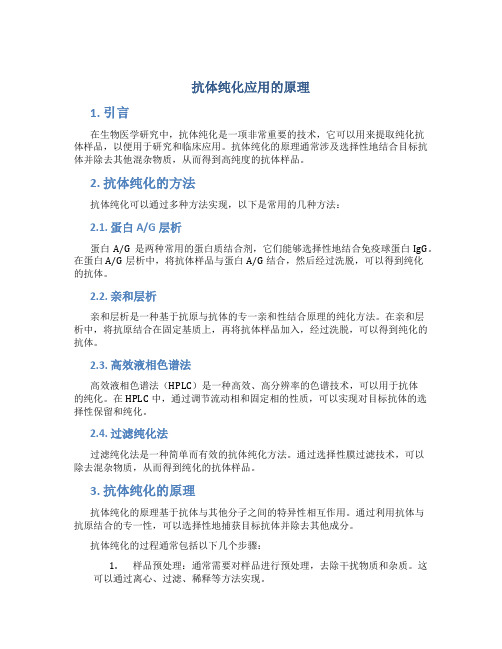
抗体纯化应用的原理1. 引言在生物医学研究中,抗体纯化是一项非常重要的技术,它可以用来提取纯化抗体样品,以便用于研究和临床应用。
抗体纯化的原理通常涉及选择性地结合目标抗体并除去其他混杂物质,从而得到高纯度的抗体样品。
2. 抗体纯化的方法抗体纯化可以通过多种方法实现,以下是常用的几种方法:2.1. 蛋白A/G层析蛋白A/G是两种常用的蛋白质结合剂,它们能够选择性地结合免疫球蛋白IgG。
在蛋白A/G层析中,将抗体样品与蛋白A/G结合,然后经过洗脱,可以得到纯化的抗体。
2.2. 亲和层析亲和层析是一种基于抗原与抗体的专一亲和性结合原理的纯化方法。
在亲和层析中,将抗原结合在固定基质上,再将抗体样品加入,经过洗脱,可以得到纯化的抗体。
2.3. 高效液相色谱法高效液相色谱法(HPLC)是一种高效、高分辨率的色谱技术,可以用于抗体的纯化。
在HPLC中,通过调节流动相和固定相的性质,可以实现对目标抗体的选择性保留和纯化。
2.4. 过滤纯化法过滤纯化法是一种简单而有效的抗体纯化方法。
通过选择性膜过滤技术,可以除去混杂物质,从而得到纯化的抗体样品。
3. 抗体纯化的原理抗体纯化的原理基于抗体与其他分子之间的特异性相互作用。
通过利用抗体与抗原结合的专一性,可以选择性地捕获目标抗体并除去其他成分。
抗体纯化的过程通常包括以下几个步骤:1.样品预处理:通常需要对样品进行预处理,去除干扰物质和杂质。
这可以通过离心、过滤、稀释等方法实现。
2.抗体捕获:根据纯化方法的选择,将样品与相应的固定基质或结合剂接触,以捕获目标抗体。
3.洗脱:通过适当的洗脱缓冲液,洗去非特异性结合的物质,从而除去杂质。
4.分离:将洗脱后的溶液进行分离,可以通过离心、过滤、纯化柱等方法分离目标抗体。
5.浓缩和纯化:最后,对目标抗体进行浓缩和纯化处理,以获得高纯度的抗体样品。
4. 抗体纯化的应用抗体纯化在生物医学研究和临床应用中有广泛的应用。
以下是一些常见的抗体纯化应用:•生物学研究:纯化的抗体用于生物学研究,如免疫组化、免疫印迹、流式细胞术等。
抗体的纯化与检测详细版

注意事项:选择 合适的荧光标记 抗体避免非特异 性结合
抗体纯化与检测的应 用
疾病诊断
抗体检测:通过检测抗体水平判断疾病状态 抗体纯化:提高抗体检测的准确性和灵敏度 抗体检测的应用:用于诊断多种疾病如传染病、肿瘤等 抗体纯化的应用:提高抗体检测的特异性和灵敏度降低假阳性和假阴性率
药物研发
抗体纯化与检测在药物研发中的作用:提高药物的疗效和安全性 抗体纯化与检测在药物研发中的具体应用:抗体筛选、抗体工程、抗体药物研发等 抗体纯化与检测在药物研发中的技术难点:抗体的纯化、抗体的检测、抗体的稳定性等 抗体纯化与检测在药物研发中的发展趋势:抗体药物的个性化治疗、抗体药物的靶向治疗等
步骤:样品制备、 电泳分离、转膜、 封闭、抗体孵育、 显色、结果分析
优点:灵敏度高、 特异性强、操作 简便、结果直观
应用:广泛应用 于蛋白质表达分 析、疾病诊断、 药物研发等领域
流式细胞术
原理:利用荧光 标记抗体通过流 式细胞仪检测细 胞表面抗原
优点:快速、灵 敏、准确
应用:免疫学、 肿瘤学、血液学 等领域
根据实验目的选 择检测方法:如 定量检测、定性 检测等
实验数据的分析和解读
数据的完整性:确保实验数 据的完整性避免遗漏和缺失
数据的时效性:确保实验数 据的时效性避免过时和失效
实验数据的准确性:确保实 验数据的准确性避免误差和 偏差
数据的解读:根据实验数据 进行合理的分析和解读得出
结论和结论
感谢您的耐心观看
生物科学研究
抗体纯化与检测在 生物科学研究中的 重要性
抗体纯化与检测在 生物科学研究中的 应用实例
抗体纯化与检测在 生物科学研究中的 发展趋势
抗体纯化与检测在 生物科学研究中的 挑战与机遇
抗体纯化的原理和步骤
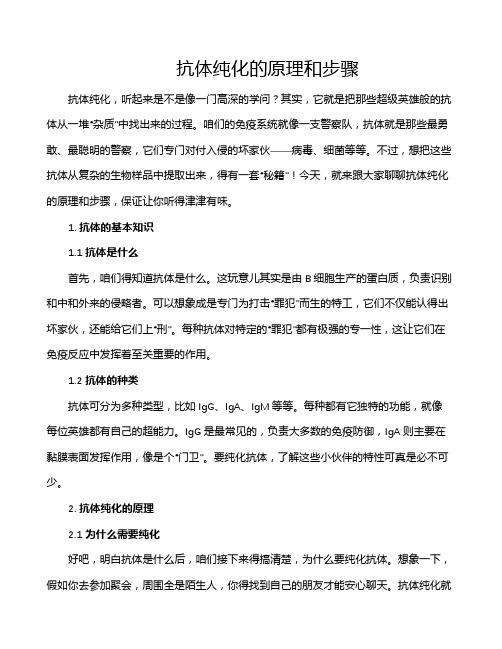
抗体纯化的原理和步骤抗体纯化,听起来是不是像一门高深的学问?其实,它就是把那些超级英雄般的抗体从一堆“杂质”中找出来的过程。
咱们的免疫系统就像一支警察队,抗体就是那些最勇敢、最聪明的警察,它们专门对付入侵的坏家伙——病毒、细菌等等。
不过,想把这些抗体从复杂的生物样品中提取出来,得有一套“秘籍”!今天,就来跟大家聊聊抗体纯化的原理和步骤,保证让你听得津津有味。
1. 抗体的基本知识1.1 抗体是什么首先,咱们得知道抗体是什么。
这玩意儿其实是由B细胞生产的蛋白质,负责识别和中和外来的侵略者。
可以想象成是专门为打击“罪犯”而生的特工,它们不仅能认得出坏家伙,还能给它们上“刑”。
每种抗体对特定的“罪犯”都有极强的专一性,这让它们在免疫反应中发挥着至关重要的作用。
1.2 抗体的种类抗体可分为多种类型,比如IgG、IgA、IgM等等。
每种都有它独特的功能,就像每位英雄都有自己的超能力。
IgG是最常见的,负责大多数的免疫防御,IgA则主要在黏膜表面发挥作用,像是个“门卫”。
要纯化抗体,了解这些小伙伴的特性可真是必不可少。
2. 抗体纯化的原理2.1 为什么需要纯化好吧,明白抗体是什么后,咱们接下来得搞清楚,为什么要纯化抗体。
想象一下,假如你去参加聚会,周围全是陌生人,你得找到自己的朋友才能安心聊天。
抗体纯化就是这样的过程——把那些“杂质”都清理掉,只留下那些“志同道合”的抗体。
纯化后的抗体才能够更有效地用于科研、治疗等各种用途。
2.2 纯化的方法抗体纯化的方法有不少,比如亲和层析、盐析、透析等等。
亲和层析可以说是个“万里挑一”的高手,它利用抗体和抗原之间的特异性结合,像钓鱼一样,把目标抗体捞出来。
盐析则是利用盐的溶解度差异,让抗体聚集在一起,轻松搞定一部分杂质。
而透析就像是洗衣机,把不需要的“小毛病”洗掉,留下干净的抗体。
3. 抗体纯化的步骤3.1 实验步骤详解接下来,咱们就聊聊具体的步骤吧。
首先,得准备好样品,通常是血清或细胞培养液。
抗体的纯化原理
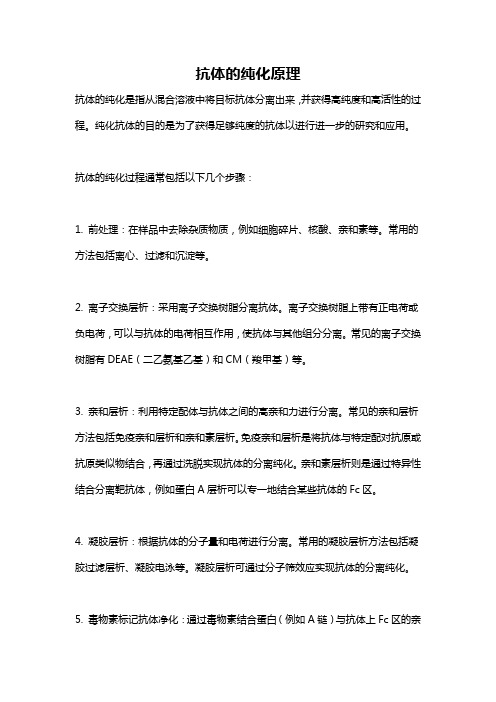
抗体的纯化原理抗体的纯化是指从混合溶液中将目标抗体分离出来,并获得高纯度和高活性的过程。
纯化抗体的目的是为了获得足够纯度的抗体以进行进一步的研究和应用。
抗体的纯化过程通常包括以下几个步骤:1. 前处理:在样品中去除杂质物质,例如细胞碎片、核酸、亲和素等。
常用的方法包括离心、过滤和沉淀等。
2. 离子交换层析:采用离子交换树脂分离抗体。
离子交换树脂上带有正电荷或负电荷,可以与抗体的电荷相互作用,使抗体与其他组分分离。
常见的离子交换树脂有DEAE(二乙氨基乙基)和CM(羧甲基)等。
3. 亲和层析:利用特定配体与抗体之间的高亲和力进行分离。
常见的亲和层析方法包括免疫亲和层析和亲和素层析。
免疫亲和层析是将抗体与特定配对抗原或抗原类似物结合,再通过洗脱实现抗体的分离纯化。
亲和素层析则是通过特异性结合分离靶抗体,例如蛋白A层析可以专一地结合某些抗体的Fc区。
4. 凝胶层析:根据抗体的分子量和电荷进行分离。
常用的凝胶层析方法包括凝胶过滤层析、凝胶电泳等。
凝胶层析可通过分子筛效应实现抗体的分离纯化。
5. 毒物素标记抗体净化:通过毒物素结合蛋白(例如A链)与抗体上Fc区的亲和作用,实现抗体的纯化。
6. 逆流层析:通过逆向液流使混合物在固相材料中逆流,根据成分的亲和力进行分离。
逆流层析可与其他纯化方法结合使用,提高纯化效果。
7. 高效液相色谱(HPLC):利用高速流动液相通过固定相分离抗体。
常见的HPLC 方法包括离子交换HPLC、亲和HPLC、尺寸排除(分子筛)HPLC和亲和逆相(含酸)HPLC等。
8. 超滤和浓缩:通过膜过滤器来去除小分子物质,实现抗体的纯化。
在进行抗体纯化过程中,可以根据特定的抗体特性和目标纯化效果的要求选择合适的方法,也可以结合多种方法进行联合纯化,提高纯化效果和纯化收率。
总而言之,抗体的纯化过程是通过利用抗体与其他成分之间的相互作用进行分离,包括物理性质(如电荷、分子量)、结构特异性(如亲和力)和化学亲和力(如特定配体结合)等。
抗体纯化方式
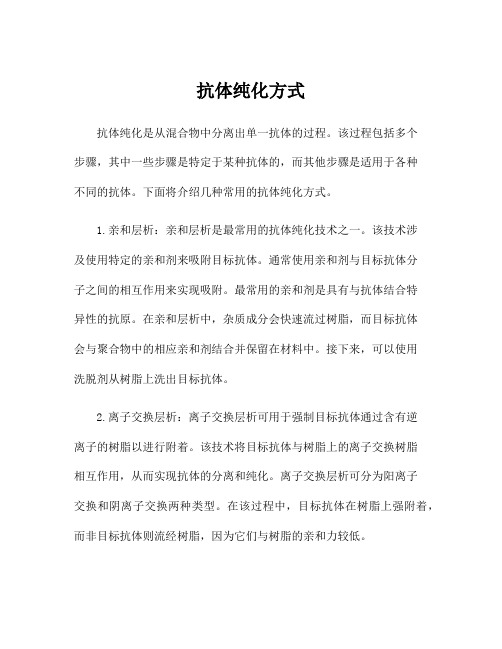
抗体纯化方式抗体纯化是从混合物中分离出单一抗体的过程。
该过程包括多个步骤,其中一些步骤是特定于某种抗体的,而其他步骤是适用于各种不同的抗体。
下面将介绍几种常用的抗体纯化方式。
1.亲和层析:亲和层析是最常用的抗体纯化技术之一。
该技术涉及使用特定的亲和剂来吸附目标抗体。
通常使用亲和剂与目标抗体分子之间的相互作用来实现吸附。
最常用的亲和剂是具有与抗体结合特异性的抗原。
在亲和层析中,杂质成分会快速流过树脂,而目标抗体会与聚合物中的相应亲和剂结合并保留在材料中。
接下来,可以使用洗脱剂从树脂上洗出目标抗体。
2.离子交换层析:离子交换层析可用于强制目标抗体通过含有逆离子的树脂以进行附着。
该技术将目标抗体与树脂上的离子交换树脂相互作用,从而实现抗体的分离和纯化。
离子交换层析可分为阳离子交换和阴离子交换两种类型。
在该过程中,目标抗体在树脂上强附着,而非目标抗体则流经树脂,因为它们与树脂的亲和力较低。
3.凝胶过滤:凝胶过滤是一种基于分子量的方法,可用于将目标抗体与其他高分子化合物分离。
在这种方法中,最初的混合物通过一种聚合物凝胶柱,分子量较大的组分无法通过凝胶,因此被分离并保留在柱中。
目标抗体分子量较小,因此可以通过凝胶流出。
4.透析:透析是一种渐进性的纯化技术,可以用于除去小分子化合物和无用的杂质,包括离子、杂质蛋白质和难溶杂质。
该过程包括使用透析袋和具有特定分子截止率的孔径尺寸的膜,并将混合物与缓冲溶液混合。
由于混合物中小分子量的组分比大分子量分子经透析膜逃逸的速度快,因此它们会在膜表面生成梯度,并被移除。
目标抗体粘附在透析袋内仍然存在。
总之,每个纯化步骤都有其优缺点,在选择纯化过程时,必须考虑到抗体的理化性质以及最终的应用目的。
一个成功的抗体纯化过程需要高纯度、高产量和快速操作的平衡。
抗体纯化的步骤
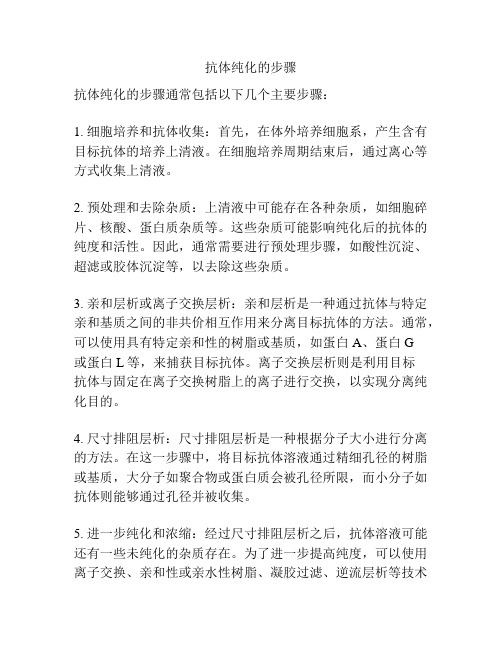
抗体纯化的步骤
抗体纯化的步骤通常包括以下几个主要步骤:
1. 细胞培养和抗体收集:首先,在体外培养细胞系,产生含有目标抗体的培养上清液。
在细胞培养周期结束后,通过离心等方式收集上清液。
2. 预处理和去除杂质:上清液中可能存在各种杂质,如细胞碎片、核酸、蛋白质杂质等。
这些杂质可能影响纯化后的抗体的纯度和活性。
因此,通常需要进行预处理步骤,如酸性沉淀、超滤或胶体沉淀等,以去除这些杂质。
3. 亲和层析或离子交换层析:亲和层析是一种通过抗体与特定亲和基质之间的非共价相互作用来分离目标抗体的方法。
通常,可以使用具有特定亲和性的树脂或基质,如蛋白A、蛋白G
或蛋白L等,来捕获目标抗体。
离子交换层析则是利用目标
抗体与固定在离子交换树脂上的离子进行交换,以实现分离纯化目的。
4. 尺寸排阻层析:尺寸排阻层析是一种根据分子大小进行分离的方法。
在这一步骤中,将目标抗体溶液通过精细孔径的树脂或基质,大分子如聚合物或蛋白质会被孔径所限,而小分子如抗体则能够通过孔径并被收集。
5. 进一步纯化和浓缩:经过尺寸排阻层析之后,抗体溶液可能还有一些未纯化的杂质存在。
为了进一步提高纯度,可以使用离子交换、亲和性或亲水性树脂、凝胶过滤、逆流层析等技术
来进行后续的纯化和浓缩。
6. 再溶和储存:最后,将纯化的抗体溶液进行最终的调整、再溶和储存,使其达到理想的浓度和稳定性,以备后续实验或应用使用。
需要注意的是,实际的抗体纯化步骤可能因为目标抗体的性质、所用的纯化技术的选择和实验室的具体流程而有所不同。
上述步骤只是一般的抗体纯化常见方法的大致流程。
27抗体的纯化——沉淀法
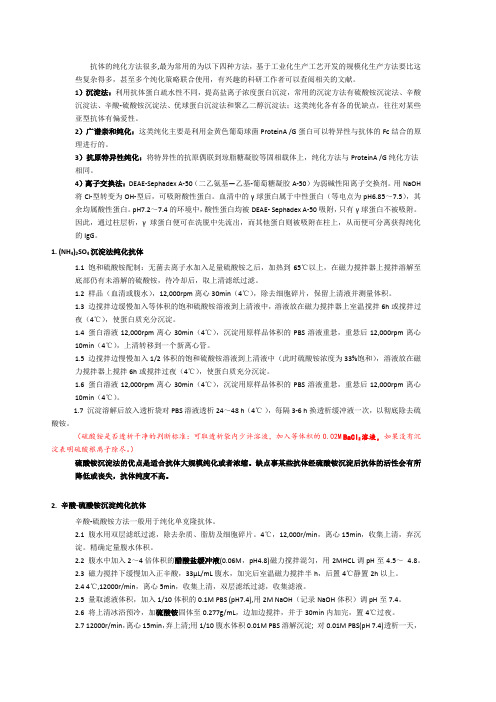
抗体的纯化方法很多,最为常用的为以下四种方法,基于工业化生产工艺开发的规模化生产方法要比这些复杂得多,甚至多个纯化策略联合使用,有兴趣的科研工作者可以查阅相关的文献。
1)沉淀法:利用抗体蛋白疏水性不同,提高盐离子浓度蛋白沉淀,常用的沉淀方法有硫酸铵沉淀法、辛酸沉淀法、辛酸-硫酸铵沉淀法、优球蛋白沉淀法和聚乙二醇沉淀法;这类纯化各有各的优缺点,往往对某些亚型抗体有偏爱性。
2)广谱亲和纯化:这类纯化主要是利用金黄色葡萄球菌ProteinA /G蛋白可以特异性与抗体的Fc结合的原理进行的。
3)抗原特异性纯化:将特异性的抗原偶联到琼脂糖凝胶等固相载体上,纯化方法与ProteinA /G纯化方法相同。
4)离子交换法:DEAE-Sephadex A-50(二乙氨基—乙基-葡萄糖凝胶A-50)为弱碱性阳离子交换剂。
用NaOH 将Cl-型转变为OH-型后,可吸附酸性蛋白。
血清中的γ球蛋白属于中性蛋白(等电点为pH6.85~7.5),其余均属酸性蛋白。
pH7.2~7.4的环境中,酸性蛋白均被DEAE- Sephadex A-50吸附,只有γ球蛋白不被吸附。
因此,通过柱层析,γ球蛋白便可在洗脱中先流出,而其他蛋白则被吸附在柱上,从而便可分离获得纯化的IgG。
1. (NH4)2SO4沉淀法纯化抗体1.1 饱和硫酸铵配制:无菌去离子水加入足量硫酸铵之后,加热到65℃以上,在磁力搅拌器上搅拌溶解至底部仍有未溶解的硫酸铵,待冷却后,取上清滤纸过滤。
1.2 样品(血清或腹水),12,000rpm离心30min(4℃),除去细胞碎片,保留上清液并测量体积。
1.3 边搅拌边缓慢加入等体积的饱和硫酸铵溶液到上清液中,溶液放在磁力搅拌器上室温搅拌6h或搅拌过夜(4℃),使蛋白质充分沉淀。
1.4 蛋白溶液12,000rpm离心30min(4℃),沉淀用原样品体积的PBS溶液重悬,重悬后12,000rpm离心10min(4℃),上清转移到一个新离心管。
常用抗体纯化方法

常用抗体纯化方法抗体纯化是分离和纯化单克隆或多克隆抗体的方法,以获得高纯度和高活性的抗体样品。
常用的抗体纯化方法包括亲和层析法、离子交换层析法、凝胶过滤法、亲和电泳法、硫酸铵沉淀法等等。
下面将对常用的抗体纯化方法进行详细介绍。
1.亲和层析法:亲和层析法是一种基于抗原-抗体互作原理的分离纯化方法。
先制备含有抗原的固相材料,如亲和树脂或亲和膜,然后将抗体样品与这些固相材料接触,使抗体与抗原结合,其他非特异性蛋白质被洗脱,最后用适当的溶液洗脱目标抗体。
这种方法可以用于多克隆或单克隆抗体的纯化。
2.离子交换层析法:离子交换层析法是利用样品中的离子性蛋白质与离子交换树脂(正离子交换或负离子交换)之间的相互作用进行分离的方法。
通过改变洗脱缓冲液的离子强度和pH值,可以将目标抗体从离子交换树脂上洗脱下来。
这种方法适用于广泛的抗体样品,可以快速纯化大量的抗体。
3.凝胶过滤法:凝胶过滤法是一种分子大小分离纯化方法,适用于分离分子量较大的抗体。
基本原理是通过调节凝胶孔隙大小,使大分子如抗体可以滞留在凝胶中,而小分子如低分子量杂质则可以通过凝胶孔隙逸出。
这种方法操作简单,纯化速度快,适合于大量抗体的纯化。
4.亲和电泳法:亲和电泳法是利用抗体在电场中迁移速度与分子特性有关的原理进行纯化的方法。
可以通过改变电场强度、溶液pH值和溶液离子浓度等参数来调节抗体的迁移速度,从而实现抗体的纯化。
亲和电泳法适用于纯化低丰度目标抗体和快速分离纯化。
5.硫酸铵沉淀法:硫酸铵沉淀法是利用硫酸铵的沉淀作用将目标抗体从混合物中分离出来的方法。
通过调节溶液的硫酸铵饱和度和沉淀时间,可以得到纯度较高的抗体样品。
该方法简单、快速,适用于大量抗体的纯化。
总的来说,抗体纯化方法有很多种,每种方法都有其特点和适用范围。
在实际应用中,可以根据具体的实验要求和抗体性质选择最适合的纯化方法。
同时,也可以结合两种或多种方法进行联合纯化,以获得更高纯度和活性的抗体。
- 1、下载文档前请自行甄别文档内容的完整性,平台不提供额外的编辑、内容补充、找答案等附加服务。
- 2、"仅部分预览"的文档,不可在线预览部分如存在完整性等问题,可反馈申请退款(可完整预览的文档不适用该条件!)。
- 3、如文档侵犯您的权益,请联系客服反馈,我们会尽快为您处理(人工客服工作时间:9:00-18:30)。
Jiangnan University
• 3.Synthetic ligands
• 1. biospecific ligands
• 1.1 Staphylococcal protein A (SpA)
• Crystallographic studies showed that protein A binds to the Fc region of IgG at the junction between its CH2 and CH3 domains. It is also found to bind the heavy chain variable region between CDR2 and CDR3
2、 Pseudobiospecific ligands
2.1、 Hydrophobic charge-induction chromatography (HCIC)
原理:利用高密度的疏水基团实现疏水作用结合;通过 调节溶液 pH 值引入静电排斥作用协助解吸,实现有效 洗脱。 抗体保守区域(Fc区)含有大量疏水氨基酸Trp、Phe等。 常用配基:4-巯基乙基吡啶(MEP)
仿生物特异性配基物
合成配基
Protein A Protein G Protein L
HCIC IMAC
Ligand 8/7
优 选择性强 点
①化学配基价格相对便宜②
配基稳定,再生容易,可多
次重复使用③抗体吸附容量 高较 Protein A 高④洗脱 p H 值在 4 左右⑤亲和力适中, 不易引起抗体结构变异。
可靠,便宜,可以
纯化的抗体范围广, 尤其适合纯化scFv。
缺 配基费用高,再生 选择性差 点 困难,重复使用有
限稳定性差。配基
来源于细菌,有潜 在的污染物如:DNA、 热源、病毒等。抗
体吸附容量不高, 需要低PH洗脱,易 造成抗体聚集。
发展时间短,与抗
体的作用机理不清 楚,不便进行优化。
Jiangnan University
Jiangnan University
• 1.3 Peptostreptococcus magnus protein L
its nanomolar affinity towards kappa (κ) light chains of variable region of antibody. It binds specifically to κ 1, κ 3 and κ 4 subclasses of the antibody light chains while not recognizing κ2 and λ subgroups.
Jiangnan University
抗体的纯化原理与方法
Jiangnan University
Jiangnan University
Jiangnan University
affinity chromatography
1、The use of biospecific ligands in affinity chromatography 2、 Pseudobiospecific ligands 3、 Synthetic ligands
Jiangnan University
• 2.2 Immobilized metal affinity chromatography (IMAC).
• Biomolecules with exposed His, Cys, Ser, Glu, Asp and Trp have affinity towards metal ions.
• Artificial Peptostreptococcus.magnus proteinL (PpL) mimic——ligand 8/7
识别IgG部位 具体类型
Protein L
Artificial protein L
轻链
轻链
Κ1型、κ3型、κ4型 λ 型、Κ1型、κ2型、 κ3型、κ4型
Hale Waihona Puke 生物特异性配基CDR区:决定簇互补区,分别 位于24-34,、50-65、95-102 位氨基酸
1.2 streptococcal protein G(SpG)
• it binds strongly to the Fc region of IgG. It is also reported to possess low affinity towards the CH1 domain of Fab region, thus, allowing purification of Fab fragments through a b-zipper interaction.
